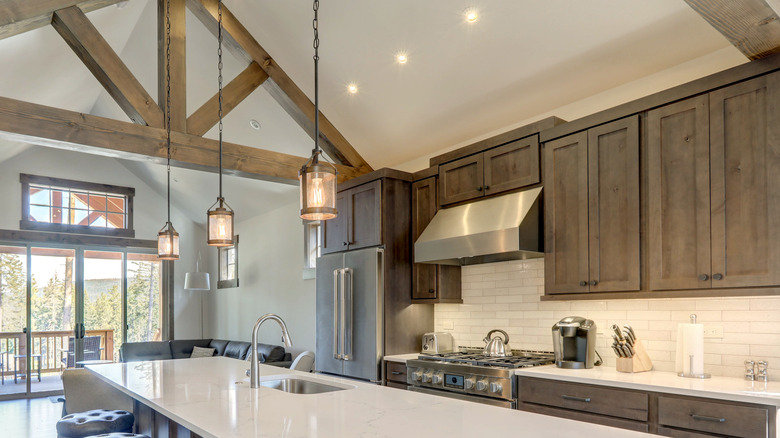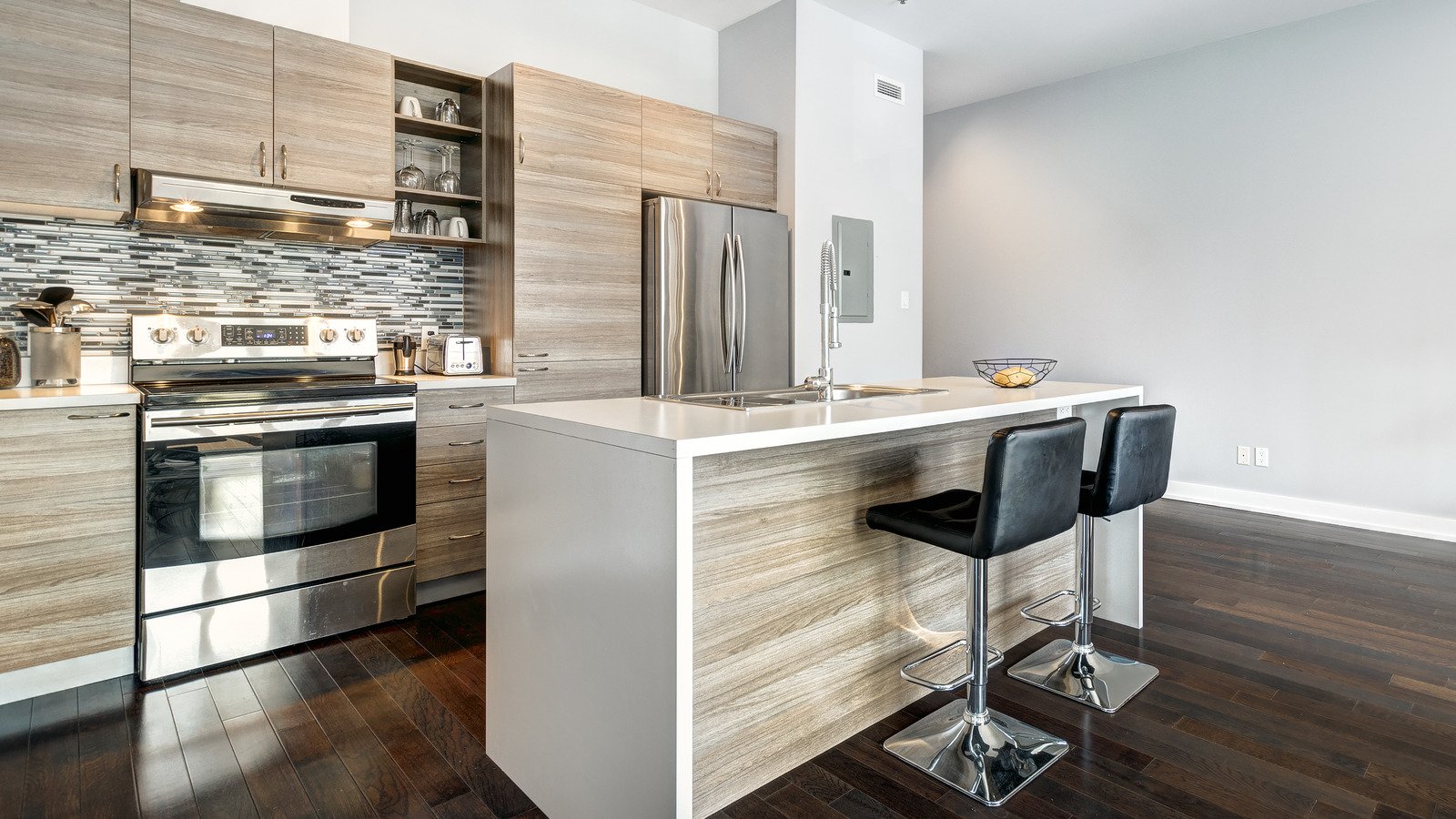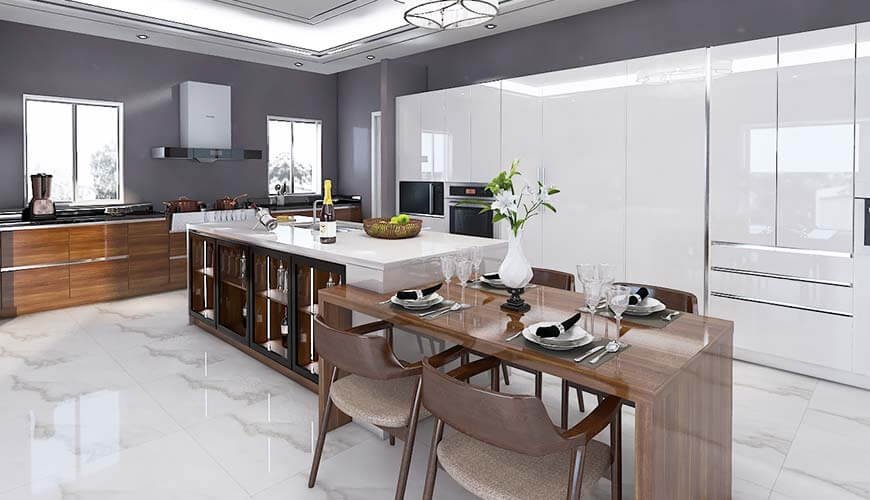Kitchen cabinets often do not reach the ceiling due to design preferences and practicality. This leaves space for decorations or storage.
Kitchen cabinets that do not extend to the ceiling provide flexibility in design and functionality. The gap can be used for aesthetic purposes, such as displaying decorative items, plants, or artwork. It also offers an opportunity for additional storage space for less frequently used items.
This design choice can make the kitchen feel more open and less cramped, especially in smaller spaces. Opting for cabinets that stop short of the ceiling can also make maintenance easier, as cleaning the tops of the cabinets becomes more manageable. Overall, this design trend combines practicality with the opportunity to personalize your kitchen space.

Credit: www.thriftydecorchick.com
Table of Contents
ToggleDesign Aesthetics
When designing a kitchen, the placement of cabinets is crucial. Cabinets that do not go to the ceiling can create a unique design aesthetic. This design can provide a sense of openness and style.
Visual Balance
Visual balance is key in kitchen design. Cabinets that stop short of the ceiling can achieve this balance. They prevent the kitchen from feeling cramped. Taller cabinets can sometimes overwhelm a space. Shorter cabinets create room for décor or lighting fixtures.
This approach draws the eye upwards. It makes the kitchen appear more spacious. The gap between the cabinets and the ceiling can be used creatively. You can add plants, decorative items, or even small appliances.
Color Coordination
Color coordination plays a significant role in this design choice. When cabinets do not reach the ceiling, the color of the wall above them becomes important. This space can be painted a different color to create contrast. It can also be used to extend the color scheme of the kitchen.
Here are a few tips for effective color coordination:
- Matching Tones: Use similar tones for a cohesive look.
- Contrast: Choose contrasting colors for a bold effect.
- Accent Colors: Use the space for accent colors to add interest.
Proper color coordination enhances the visual appeal of the kitchen. It makes the entire room feel more thought-out and stylish.
| Design Element | Benefit |
|---|---|
| Visual Balance | Prevents a cramped feeling, adds openness |
| Color Coordination | Enhances overall aesthetics, adds depth |

Credit: www.housedigest.com
Storage Optimization
Kitchen cabinets that do not reach the ceiling can feel like a missed opportunity. You can turn this gap into a valuable storage area. Proper storage optimization can help you make the most of this space.
Utilize Open Space
The open space above your kitchen cabinets can serve many purposes. Decorative items like plants or vases add a personal touch. You can store less-used items in stylish boxes or baskets. This makes them accessible yet out of the way.
| Item Type | Storage Idea |
|---|---|
| Decorative Items | Plants, Vases |
| Less-used Kitchenware | Stylish Boxes, Baskets |
Incorporate Shelves
Shelves can be a game-changer in your kitchen. They can fit perfectly into the gap above your cabinets. Shelves provide additional storage without making the space look cluttered. Consider adjustable shelves to suit different heights of items.
- Place cookbooks on shelves for easy access.
- Use shelves for spice jars and condiments.
- Add decorative jars or containers to store dry goods.
By using shelves, you gain extra storage and create a visually appealing space. Shelves can easily be installed and customized to your needs.
Lighting Enhancements
Lighting enhancements can transform your kitchen into a warm and inviting space. Proper lighting not only improves functionality but also adds a touch of elegance. When kitchen cabinets do not go to the ceiling, there are unique opportunities for creative lighting solutions.
Under-cabinet Lighting
Under-cabinet lighting enhances visibility on countertops. It makes cooking and food preparation easier. This type of lighting is often energy-efficient and can be easily installed.
- LED strip lights are popular for under-cabinet lighting.
- They provide bright and even illumination.
- Puck lights are another option for focused light.
Under-cabinet lights also add a modern touch to your kitchen. They can be installed with dimmer switches for adjustable brightness. This allows you to set the mood for different occasions.
Ambient Illumination
Ambient illumination creates a cozy atmosphere in your kitchen. It fills the space with soft, indirect light. This type of lighting is perfect for social gatherings and family dinners.
- Install LED lights above the cabinets.
- Use light strips for an even glow.
- Choose warm white lights for a relaxing ambiance.
Ambient lighting can highlight decorative items placed above the cabinets. It draws attention to these features, making your kitchen more attractive. Use a combination of ambient and task lighting for a well-lit space.
Remember to choose energy-efficient lighting options. This saves on your electricity bill and helps the environment. Smart lighting systems can also be used for convenience. They allow you to control your lights with a smartphone or voice commands.
| Lighting Type | Benefits |
|---|---|
| Under-Cabinet Lighting | Improves visibility, easy installation, energy-efficient |
| Ambient Illumination | Creates a cozy atmosphere, highlights decor, energy-saving |
Decorative Elements
Kitchen cabinets that do not reach the ceiling offer a unique opportunity. You can use the space above them to add decorative elements. This area can become a focal point in your kitchen. Explore different ways to make this space both functional and beautiful.
Display Art Pieces
Displaying art pieces above your cabinets can elevate your kitchen’s look. Choose pieces that match your kitchen’s theme. Ensure the art is of the right size and proportion. Use frames that complement your kitchen’s color scheme. Remember to dust these pieces regularly to keep them looking fresh.
| Art Type | Ideal Placement |
|---|---|
| Paintings | Centered above cabinets |
| Sculptures | Evenly spaced |
| Framed Photos | Grouped together |
Add Greenery
Adding greenery above your cabinets brings life to your kitchen. Choose plants that thrive indoors and need low maintenance.
- Pothos
- Spider Plant
- Succulents
Place them in decorative pots that match your kitchen’s style. Rotate the plants to ensure even light exposure. Water them as needed to keep them healthy and vibrant.
Functional Upgrades
Functional Upgrades can make your kitchen more efficient and stylish. If your kitchen cabinets do not reach the ceiling, you can use the extra space for smart storage solutions. Here are two practical ways to utilize this gap effectively.
Install Hooks
Hooks can be a game-changer in your kitchen. They provide extra storage for items like pots, pans, and utensils.
- Easy Access: Hang frequently used items for quick reach.
- Organized Space: Keep your countertops clutter-free.
- Versatile Use: Use hooks for cups, keys, or even plants.
By installing hooks, you can transform the unused space into a functional area. You can easily install them under the cabinets or on the walls.
Use Magnetic Strips
Magnetic strips are another great way to utilize the space under your cabinets. They are perfect for storing metal items.
- Knife Storage: Keep your knives within reach and save drawer space.
- Tool Organization: Store metal utensils and kitchen tools easily.
- Safety: Prevent accidents by keeping sharp items off the counter.
Magnetic strips are easy to install and maintain. They can hold various metal items securely and neatly.
These functional upgrades can make your kitchen more organized and efficient. Use hooks and magnetic strips to maximize the space under your kitchen cabinets. This will not only add to the kitchen’s functionality but also its aesthetic appeal.
Maintenance Tips
Kitchen cabinets that do not go to the ceiling can collect dust and grime. Proper maintenance is essential to keep them clean and looking new. Here are some effective tips to maintain your kitchen cabinets.
Dust Management
Dust can easily accumulate on top of your cabinets. Regular dusting helps keep your kitchen clean. Use a soft cloth or microfiber duster to wipe the surfaces.
- Dust weekly to prevent buildup.
- Use a step ladder for hard-to-reach areas.
- Consider placing wax paper on top to catch dust.
Wax paper can be replaced every few months. This makes cleaning easier and faster.
Easy Cleaning Solutions
Grease and grime can stick to your cabinets. Simple cleaning solutions can help keep them spotless.
| Cleaning Solution | Ingredients | Instructions |
|---|---|---|
| Vinegar Spray | 1 cup vinegar 2 cups water |
Mix in a spray bottle. Spray and wipe with a cloth. |
| Soap Solution | 1 tbsp dish soap 2 cups warm water |
Mix in a bowl. Dip cloth, wring out, and wipe. |
Use these solutions every two weeks to keep cabinets clean. Avoid harsh chemicals that can damage the finish.
Custom Cabinet Options
Kitchen cabinets that do not go to the ceiling provide many custom options. You can select from a wide range of designs and styles. Custom cabinets can fit any kitchen size and layout. Here, we will explore two popular custom cabinet options.
Built-in Cabinets
Built-in cabinets are fixed to the walls. They give a sleek look. These cabinets maximize storage space. They can be designed to fit any wall size. Built-in cabinets offer a clean, uncluttered appearance. You can choose different materials and finishes. Wood, laminate, and metal are popular choices. Glass doors can add a touch of elegance. Add lighting inside for a modern look.
Modular Designs
Modular designs are flexible and versatile. They consist of separate units. You can mix and match these units. This allows you to create a unique layout. Modular cabinets are easy to install. They can be rearranged if needed. These designs offer different sizes and shapes. Open shelves, drawers, and closed cabinets are all options. Modular designs are great for small or large kitchens.
| Feature | Built-In Cabinets | Modular Designs |
|---|---|---|
| Flexibility | Low | High |
| Installation | Permanently fixed | Easy to install |
| Customization | High | Very High |
| Storage Options | Varied | Varied |
- Built-in cabinets offer a sleek, fixed look.
- Modular designs provide more flexibility and easy installation.

Credit: thebrainandthebrawn.com
Space Perception
Understanding space perception is crucial in kitchen design. Kitchen cabinets that do not reach the ceiling can change how a room feels. This approach can impact space perception in your kitchen. Let’s explore how ceiling height illusions and room proportions play a role.
Ceiling Height Illusions
Cabinets stopping short of the ceiling can create an illusion. The ceiling may seem higher than it is. This trick works well in small kitchens. It can make the room feel less cramped.
The gap between the cabinets and the ceiling draws the eye upward. This visual trick can make a big difference. The kitchen appears more open and airy.
Room Proportions
Room proportions change when cabinets do not reach the ceiling. The kitchen feels balanced. There is a sense of harmony.
Here are some benefits:
- More storage options
- Better visual appeal
- Improved airflow
In some kitchens, cabinets going to the ceiling can feel overwhelming. When cabinets stop short, they offer a break. This makes the room feel less cluttered.
Consider the following table for a quick comparison:
| Ceiling-Height Cabinets | Non-Ceiling-Height Cabinets |
|---|---|
| More storage | Illusion of space |
| Harder to reach | Easy access |
| Possible cluttered look | Balanced proportions |
The choice depends on your kitchen’s needs. Think about how you use the space.
Frequently Asked Questions
Why Don’t Kitchen Cabinets Reach The Ceiling?
Kitchen cabinets often don’t reach the ceiling to allow for easier access and to accommodate various ceiling heights.
What Is The Standard Height For Kitchen Cabinets?
The standard height is usually 30 to 42 inches, depending on ceiling height and design preferences.
Do Kitchen Cabinets To Ceiling Look Better?
Full-height cabinets can look sleek and modern, but may not suit every kitchen style or height.
Are Kitchen Cabinets To Ceiling Practical?
They can be practical for storage but may require a step stool to access upper shelves.
Do Kitchen Cabinets To Ceiling Add Value?
Ceiling-height cabinets can add value by maximizing storage and providing a high-end look.
How Do I Clean High Kitchen Cabinets?
Use a step stool and a microfiber cloth with mild cleaner to reach and clean high cabinets safely.
What Are Alternatives To Ceiling-high Cabinets?
Alternatives include open shelving, soffits, or decorative moldings to fill the space above cabinets.
Do Shorter Cabinets Save Money?
Yes, shorter cabinets can be less expensive due to reduced material and labor costs.
Can I Extend My Existing Cabinets To The Ceiling?
Yes, you can extend them with additional cabinetry or molding, but it may require professional installation.
What Are Design Tips For Kitchen Cabinets?
Consider your kitchen’s height, style, and storage needs when choosing cabinet height and layout.
Conclusion
Choosing cabinets that do not reach the ceiling can be a smart design choice. They offer flexibility and a unique style. This layout provides extra storage and a spacious feel. Consider this option for a modern and practical kitchen. Make the most of your space with innovative cabinet designs.


